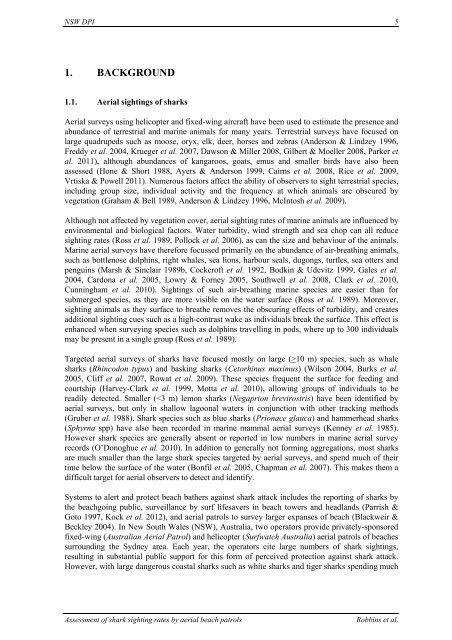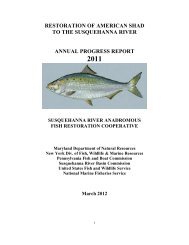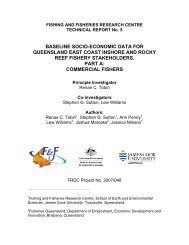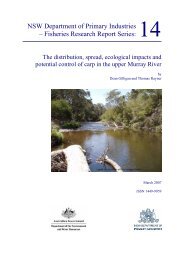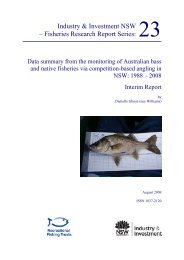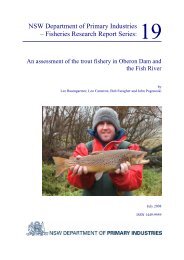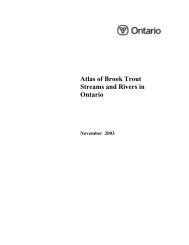Assessment of shark sighting rates by aerial ... - Fisheries Reports
Assessment of shark sighting rates by aerial ... - Fisheries Reports
Assessment of shark sighting rates by aerial ... - Fisheries Reports
Create successful ePaper yourself
Turn your PDF publications into a flip-book with our unique Google optimized e-Paper software.
NSW DPI 5<br />
1. BACKGROUND<br />
1.1. Aerial <strong>sighting</strong>s <strong>of</strong> <strong>shark</strong>s<br />
Aerial surveys using helicopter and fixed-wing aircraft have been used to estimate the presence and<br />
abundance <strong>of</strong> terrestrial and marine animals for many years. Terrestrial surveys have focused on<br />
large quadrupeds such as moose, oryx, elk, deer, horses and zebras (Anderson & Lindzey 1996,<br />
Freddy et al. 2004, Krueger et al. 2007, Dawson & Miller 2008, Gilbert & Moeller 2008, Parker et<br />
al. 2011), although abundances <strong>of</strong> kangaroos, goats, emus and smaller birds have also been<br />
assessed (Hone & Short 1988, Ayers & Anderson 1999, Cairns et al. 2008, Rice et al. 2009,<br />
Vrtiska & Powell 2011). Numerous factors affect the ability <strong>of</strong> observers to sight terrestrial species,<br />
including group size, individual activity and the frequency at which animals are obscured <strong>by</strong><br />
vegetation (Graham & Bell 1989, Anderson & Lindzey 1996, McIntosh et al. 2009).<br />
Although not affected <strong>by</strong> vegetation cover, <strong>aerial</strong> <strong>sighting</strong> <strong>rates</strong> <strong>of</strong> marine animals are influenced <strong>by</strong><br />
environmental and biological factors. Water turbidity, wind strength and sea chop can all reduce<br />
<strong>sighting</strong> <strong>rates</strong> (Ross et al. 1989, Pollock et al. 2006), as can the size and behaviour <strong>of</strong> the animals.<br />
Marine <strong>aerial</strong> surveys have therefore focussed primarily on the abundance <strong>of</strong> air-breathing animals,<br />
such as bottlenose dolphins, right whales, sea lions, harbour seals, dugongs, turtles, sea otters and<br />
penguins (Marsh & Sinclair 1989b, Cockcr<strong>of</strong>t et al. 1992, Bodkin & Udevitz 1999, Gales et al.<br />
2004, Cardona et al. 2005, Lowry & Forney 2005, Southwell et al. 2008, Clark et al. 2010,<br />
Cunningham et al. 2010). Sightings <strong>of</strong> such air-breathing marine species are easier than for<br />
submerged species, as they are more visible on the water surface (Ross et al. 1989). Moreover,<br />
<strong>sighting</strong> animals as they surface to breathe removes the obscuring effects <strong>of</strong> turbidity, and creates<br />
additional <strong>sighting</strong> cues such as a high-contrast wake as individuals break the surface. This effect is<br />
enhanced when surveying species such as dolphins travelling in pods, where up to 300 individuals<br />
may be present in a single group (Ross et al. 1989).<br />
Targeted <strong>aerial</strong> surveys <strong>of</strong> <strong>shark</strong>s have focused mostly on large (>10 m) species, such as whale<br />
<strong>shark</strong>s (Rhincodon typus) and basking <strong>shark</strong>s (Cetorhinus maximus) (Wilson 2004, Burks et al.<br />
2005, Cliff et al. 2007, Rowat et al. 2009). These species frequent the surface for feeding and<br />
courtship (Harvey-Clark et al. 1999, Motta et al. 2010), allowing groups <strong>of</strong> individuals to be<br />
readily detected. Smaller (


